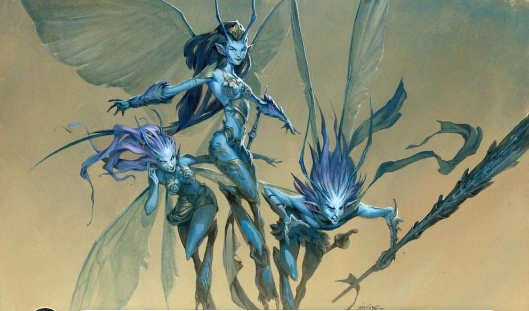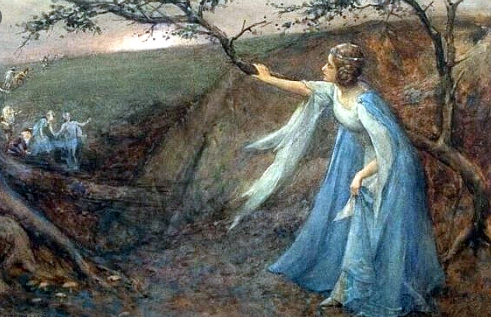Pixies and fairies are both mythical creatures often found in folklore and fantasy literature. While they share some similarities, they also have different characteristics. In this article let us differentiate pixies from fairies in the context of their origins, appearances, behaviors and cultural significance.
In this context, it important to remember that both pixies and fairies are creatures of myth and fantasy, so their characteristics and attributes can be different depending on the specific cultural context and creative interpretations.
Pixie
A pixie is a mythical creature of British folklore. Pixies are considered to be particularly concentrated in the moorland areas around Devon and Cornwall, suggesting some Celtic origin for the belief and name.
In traditional folklore, pixies are usually depicted as mischievous, short of stature and attractively childlike. They are fond of dancing and gather outdoors in huge numbers to dance or sometimes wrestle. Other traditional stories describe them as ill-clothed or naked- wearing dirty ragged bundles of rags which they happily discard for gifts of new clothes.
In modern folklore they are generally depicted with pointed ears and often wearing a green outfit and pointed hat. Sometimes their eyes are described as being pointed upwards at the temple ends. Some pixies are said to steal children or lead travelers astray while some are said to reward consideration and punish neglect on the part of larger humans. By their presence they bring blessings to those who are fond of them.

Fairy
A fairy is a type of mythical or legendary creature in European folklore, a form of spirit often described as metaphysical, supernatural or preternatural. Myths and stories about fairies do not have a single origin, but are rather a collection of folklore beliefs from disparate sources.
Fairies were a common feature of Renaissance literature and Romantic art and were especially popular in the United Kingdom during the Victorian and Edwardian eras. The Celtic Revival also saw fairies established as conical part of Celtic cultural heritage.
The fairies of the past were feared as dangerous and powerful beings who were sometimes friendly to humans but could also be cruel or mischievous. Fairies can appear as a dwarf creature typically having green clothes and hair, living underground or in stone heaps.
Modern fairies are generally depicted as being characteristically beautiful or handsome and as having lives corresponding to those of human beings, though longer.

Pixie vs Fairy: Key Takeaways
Origin and Culture
- Pixies are usually associated with Celtic folklore, particularly in the British Isles. They are often depicted as mischievous and playful beings, known for pranks and tricks.
- Fairies have a more diverse cultural background, appearing in many mythologies around the world, including European, Middle Eastern, and African traditions. They usually possess magical abilities and are sometimes considered protectors of nature.
Appearance
- Pixies are usually portrayed as small, humanoid creatures with pointed ears. They are typically depicted with a more human-like appearance, though sometimes with wings.
- Fairies can be different in appearance, from tiny, delicate beings with insect-like wings to more human-like figures with ethereal features. They usually have wings that resemble those of butterflies or dragonflies.
Nature
- Pixies are commonly associated with wild and natural landscapes, often residing in forests, meadows, or near water sources.
- Fairies can inhabit different environments like forests, gardens, and even urban settings. Their habitats can be more diverse than those of pixies.
Personality
- Pixies are known for their mischievous and sometimes prankster-like behavior. They may lead travelers astray or play tricks on unsuspecting individuals.
- Fairies’ personalities can range from mischievous to benevolent. Some fairies are seen as helpful and kind, while others can be capricious or even malicious.
Size
- Pixies are generally depicted as smaller beings, often around a foot tall or shorter.
- Fairies are depicted from tiny creatures just a few inches tall to human-sized or even larger in some myths.
Cultural Depictions
- Pixies are frequently featured in English and Celtic folklore, with stories often highlighting their interactions with humans.
- Fairies are present in many cultural traditions and have been depicted in literature, art, and oral stories from various parts of the world.
Magical Abilities
- Pixies are usually associated with nature magic, such as controlling plants, influencing weather, or communicating with animals.
- Fairies are commonly depicted as possessing a broader range of magical powers, including the ability to grant wishes, cast spells and enchant objects.
Social Behavior
- Pixies are sometimes portrayed as living in close-knit communities or tribes, often engaging in group activities.
- Fairies’ social structures can vary. Some are shown as solitary creatures, while others live in larger groups or courts.
Legends and Stories
- Pixies are featured in stories that emphasize their trickster nature and interactions with humans, such as leading travelers astray or causing mishaps.
- Fairy tales often involve fairies granting wishes, assisting or testing humans, and exploring themes of morality and magic.
Cultural Impact
- Pixies have a more localized cultural impact, particularly in Celtic regions of the British Isles.
- Fairies have a more global cultural presence due to their appearances in diverse mythologies and their widespread incorporation into fantasy literature and media.
Also Read: Difference Between Mermaid And Sirens
Pixie vs Fairy: Key Takeaways
| BASIS OF COMPARISON | PIXIE | FAIRY |
| Description | Pixies mostly belong to the characters that have a negative role in the movie or literature and may change to good ones latter. | Fairy mostly acts as a positive character that shows people the right path and therefore has an important role until the end. |
| Appearance | Pixies have colored skin and hair with butterfly wings. | Fairies are just like miniature human beings with large wings on their backs. |
| Presence | Pixies are mostly found in Celtic folklore. | Fairies are commonly found in Celtic folklore. |
| Size | Pixies are four inches tall and are known to live in gardens. | Fairies are taller and are about six inches tall. |
| Size | Pixies are often described to be smaller than fairies. They have pointed ears. | Fairies are often described as human in appearance. They have a pair of wings. |
| Dwelling | Pixies live in gardens. | Fairies are known to live under the water or in the hills. |
| Magical Powers | Pixies are said to have more magical powers such as bestowing wealth, kindness and intelligence. | Fairies are also known to have powers to change the curious aspects of nature. |
| Depiction | Pixies in folklore are often naked or poorly dressed, but in modern portrayals they often wear a green outfits and pointy hats. | Fairies are generally portrayed as elegantly and beautifully dressed. |
| Gender | There are both male and female fairies. | It is difficult to say the gender of a pixie. |
| Popularity | Pixies are commonly known for misleading and dancing. | Fairies are glorified for their ethereal beauty. |